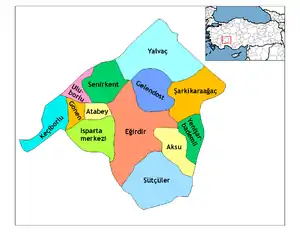Isparta
Isparta (Greek: Σπάρτη, Baris/Βάρις in Byzantine Greek) is a city in western Turkey and the capital of Isparta Province. The city's population was 222,556 in 2010 and its elevation is 1035 m. It is known as the "City of Roses".
Isparta | |
|---|---|
%252Cavw_(NBO-IST(-AMS)_Isparta%252CTR_tue08feb2011-1414h.jpg.webp) Isparta from the air (February 2011) | |
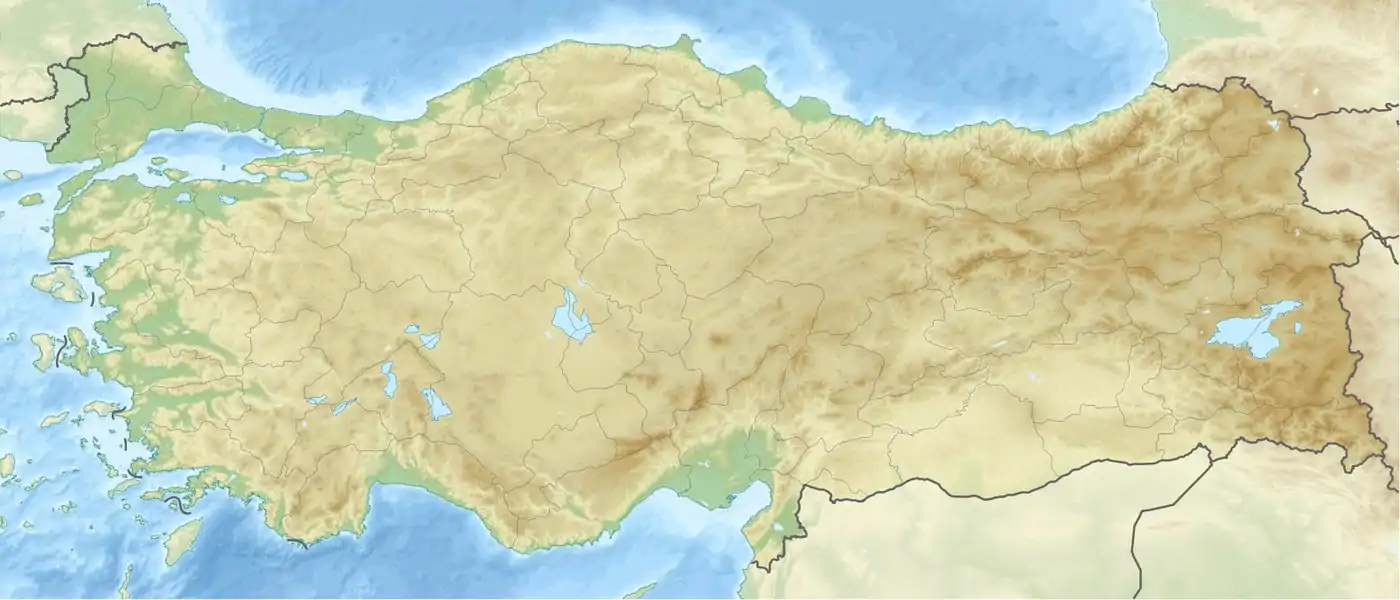 Isparta 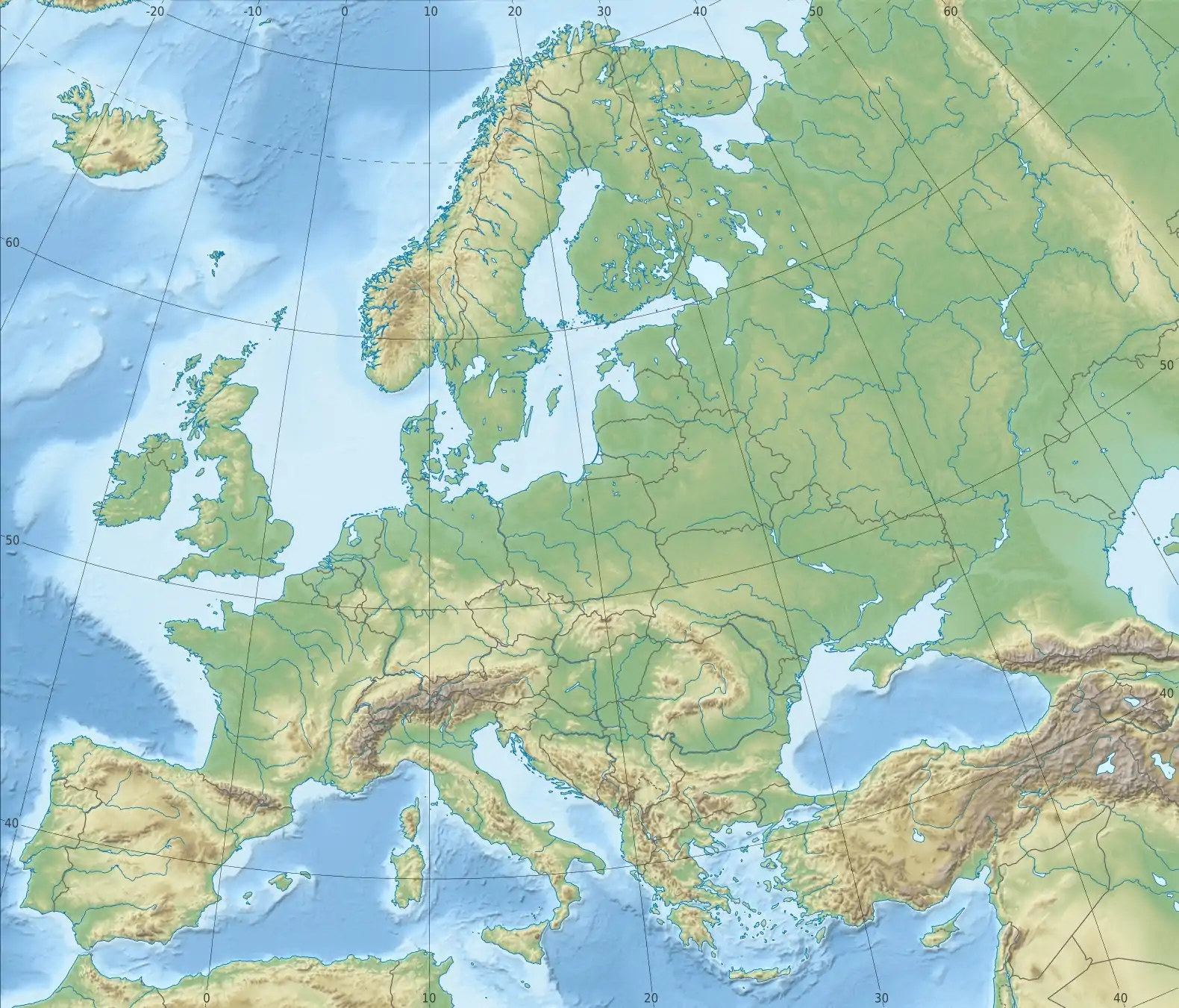 Isparta 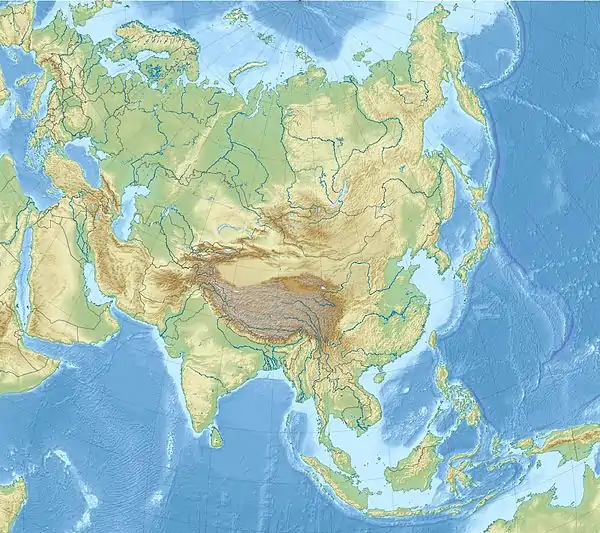 Isparta .svg.png.webp) Isparta | |
| Coordinates: 37°45′53″N 30°33′24″E | |
| Country | Turkey |
| Province | Isparta |
| District | Isparta |
| Government | |
| • Mayor | ŞÜKRÜ BAŞDEĞİRMEN (AKP) |
| Area | |
| • District | 682.41 km2 (263.48 sq mi) |
| Population (2012)[2] | |
| • Urban | 198,385 |
| • District | 219,904 |
| • District density | 320/km2 (830/sq mi) |
| Post code | 32000 |
| Website | www.isparta.bel.tr |
Isparta is well-connected to other parts of Turkey via roads. Antalya lies 130 km to the south and Eskişehir is 350 km to the north.
Süleyman Demirel University has introduced thousands of youths from varied backgrounds to the city's mostly conservative fabric in recent years. The city's football team, Ispartaspor, plays in Group 7 of the Turkish Regional Amateur League.
History
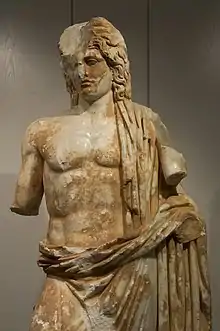
Roman era
Isparta is a Turkish spelling of Greek Sparta, by prothesis declustering.[3]
Isparta was said to correspond to the ancient city of Baris, which is a namesake and was part of the Roman province of Pisidia.[4] A later theory has it instead as the Eastern Roman fortress Saporda; in Muslim sources it appears as Sabarta.[5] GE Bean characterized the situation thus: "These perpetually shifting conceptions leave the reader quite bewildered."[6] Modern scholars locate Baris near Kılıç, in Keçiborlu district, Isparta province.[7][8]
At an early stage it became a Christian bishopric, a suffragan of the Metropolitan see of Antioch of Pisidia, the capital of the province. The names of two of its bishops are known with certainty: Heraclius participated in the First Council of Nicaea in 325 and Leo in the Second Council of Nicaea in 787. In addition, Paulus was at the Council of Constantinople (869) and Stephanus was at the Council of Constantinople (879), but one or both of these may have been of the Baris in the Roman province of Hellespontus.[9][10] Like most sees in Asia Minor, it faded away.
- 1203: Conquered by the Seljuq Turks.
- Late 13th century: Becomes part of the Hamidids.
- 1381: Isparta is sold to the Ottoman sultan Murad I by the Hamidid Emir.
- Late 19th century: Muslim refugees from the Balkans settle around Isparta. The Bulgarian refugees brought the knowledge of kazanlik rosewater production with them, leading to Isparta's nickname: city of roses.
- 1914: According to the 1914 Ottoman population statistics, the district of Isparta had a total population of 54.465, consisting of 46.698 Muslims, 6.648 Greeks and 1.119 Armenians.[11]
- 1923: The Greek inhabitants of the area were forced to move to Greece under the Greco-Turkish population exchange.
On November 30, 2007, Atlasjet Flight 4203 crashed on approach to Isparta Süleyman Demirel Airport, killing all 57 passengers and crew.
Titular see
No longer a residential bishopric, 'Baris in Pisidia' is today listed by the Catholic Church as a titular bishopric, nominal suffragan of Nicomedia,[12] since the diocese was nominally restored in 1933: Latin adjective Baren(us) in Pisidia (Latin). It has been vacant for decades, having had the following incumbents, so far of the fitting Episcopal (lowest) rank:[13]
- Alfred Bertram Leverman (1948.04.24 – 1953.07.27) as Auxiliary Bishop of Halifax (Canada) (1948.04.24 – 1953.07.27); later Bishop of Saint John, New Brunswick (Canada) (1953.07.27 – 1968.09.07), emeritate as Titular Bishop of Altava (1968.09.07 – death 1972.04.28)
- José de Almeida Batista Pereira (1953.12.22 – 1955.11.07) as Auxiliary Bishop of Niterói (Brazil) (1953.12.22 – 1955.11.07), Bishop of Sete Lagoas (Brazil) (1955.11.07 – 1964.04.02), Bishop of Guaxupé (Brazil) (1964.04.02 – retired 1976.01.16); died 2009
- António Cardoso Cunha (1956.03.09 – 1967.01.10), first as Auxiliary Bishop of Beja (Portugal) (1956.03.09 – 1965), then as Coadjutor Bishop of Vila Real (Portugal) (1965 – 1967.01.10), next succeeded as Bishop of Vila Real (1967.01.10 – retired 1991.01.19), died 2004.
Economy
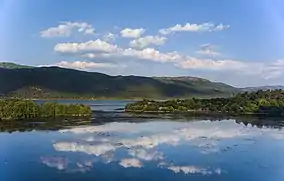
The main economic activities of Isparta are the production of rosewater and handmade carpets. Tourism, both local and increasingly international due to "biblical tourism", is becoming an important source of revenue.
In the early 20th century, carpetmaking was a major industry in Isparta.[14]
Climate
Isparta has a hot summer Mediterranean climate (Köppen climate classification: Csa) with continental influences. Winters are cool and rainy and often snowy, summers are hot and dry. The lakes around the city have an important moderating influence on the climate. Precipitation occurs mostly in January and December. Monthly rainy days decrease until August. Rainy days increase again with September.
| Climate data for Isparta | |||||||||||||
|---|---|---|---|---|---|---|---|---|---|---|---|---|---|
| Month | Jan | Feb | Mar | Apr | May | Jun | Jul | Aug | Sep | Oct | Nov | Dec | Year |
| Record high °C (°F) | 17.6 (63.7) |
19.0 (66.2) |
26.8 (80.2) |
28.4 (83.1) |
34.8 (94.6) |
36.2 (97.2) |
39.2 (102.6) |
41.2 (106.2) |
37.1 (98.8) |
32.2 (90.0) |
25.4 (77.7) |
20.0 (68.0) |
41.2 (106.2) |
| Average high °C (°F) | 6.4 (43.5) |
7.8 (46.0) |
11.6 (52.9) |
16.5 (61.7) |
21.7 (71.1) |
26.5 (79.7) |
30.3 (86.5) |
30.5 (86.9) |
26.5 (79.7) |
20.4 (68.7) |
13.8 (56.8) |
8.2 (46.8) |
18.4 (65.0) |
| Daily mean °C (°F) | 1.9 (35.4) |
2.9 (37.2) |
6.1 (43.0) |
10.7 (51.3) |
15.5 (59.9) |
20.1 (68.2) |
23.5 (74.3) |
23.2 (73.8) |
18.7 (65.7) |
13.0 (55.4) |
7.5 (45.5) |
3.5 (38.3) |
12.2 (54.0) |
| Average low °C (°F) | −1.8 (28.8) |
−1.2 (29.8) |
1.0 (33.8) |
4.9 (40.8) |
8.6 (47.5) |
12.4 (54.3) |
15.4 (59.7) |
15.1 (59.2) |
10.9 (51.6) |
6.7 (44.1) |
2.4 (36.3) |
−0.3 (31.5) |
6.2 (43.1) |
| Record low °C (°F) | −19.2 (−2.6) |
−21.0 (−5.8) |
−18.5 (−1.3) |
−7.7 (18.1) |
−1.2 (29.8) |
4.4 (39.9) |
4.9 (40.8) |
7.0 (44.6) |
−0.8 (30.6) |
−4.2 (24.4) |
−11.5 (11.3) |
−15.0 (5.0) |
−21.0 (−5.8) |
| Average precipitation mm (inches) | 78.8 (3.10) |
62.6 (2.46) |
56.8 (2.24) |
52.7 (2.07) |
53.6 (2.11) |
32.4 (1.28) |
14.3 (0.56) |
11.2 (0.44) |
16.8 (0.66) |
37.5 (1.48) |
45.6 (1.80) |
83.1 (3.27) |
545.4 (21.47) |
| Average rainy days | 12.5 | 11.1 | 11.1 | 10.7 | 10.7 | 6.8 | 3.0 | 2.2 | 3.6 | 6.6 | 7.9 | 12 | 98.2 |
| Mean monthly sunshine hours | 120.9 | 134.4 | 186 | 207 | 269.7 | 324 | 359.6 | 347.2 | 291 | 220.1 | 156 | 102.3 | 2,718.2 |
| Source 1: Turkish State Meteorological Service[15] | |||||||||||||
| Source 2: Hong Kong Observatory[16] | |||||||||||||
Sights
The city lies close to a fault line and is thus prone to violent earthquakes. Some historical buildings and houses remain from the 19th century, but are rare compared to the number of modern buildings.
There are several important mosques in Isparta, including the pre-Ottoman Hızır Bey Mosque (c. 1325), the Kutlubey or Ulu (Grand) Mosque (1429, with major restorations made in the 19th century) and Hacı Abdi Mosque (1569). The city boasts a mosque by the Ottoman royal architect Mimar Sinan — the 16th century's Firdevs Pasa mosque. It is also known as Mimar Sinan Mosque. There are several remains of Greek Orthodox churches from the Byzantine and Ottoman periods (14th–19th century). The Byzantine fortress is mostly in ruins.
 Isparta Iplik Camii 2472
Isparta Iplik Camii 2472_Cami_2435.jpg.webp) Isparta Mimar Sinan (Firdevs Paşa) Cami 2435
Isparta Mimar Sinan (Firdevs Paşa) Cami 2435_Cami_2437.jpg.webp) Isparta Mimar Sinan (Firdevs Paşa) Cami 2437
Isparta Mimar Sinan (Firdevs Paşa) Cami 2437 Isparta; Firdevs Paşa Camii von Süd
Isparta; Firdevs Paşa Camii von Süd Isparta Kutlubey Camii aka Ulu Camii 2466
Isparta Kutlubey Camii aka Ulu Camii 2466 Isparta Kutlubey Camii aka Ulu Camii 2457
Isparta Kutlubey Camii aka Ulu Camii 2457 Isparta Kutlubey Camii aka Ulu Camii 2461
Isparta Kutlubey Camii aka Ulu Camii 2461
The city also has a museum.
 Isparta museum Early Bronze Age vessels 4945
Isparta museum Early Bronze Age vessels 4945 Isparta museum Late Archaic stele 2796
Isparta museum Late Archaic stele 2796 Isparta museum Late Archaic steles 4990
Isparta museum Late Archaic steles 4990 Isparta museum Eğirdir treasure 4965
Isparta museum Eğirdir treasure 4965 Isparta museum Anatolian dresses 4973
Isparta museum Anatolian dresses 4973 Isparta museum church bell 2808
Isparta museum church bell 2808
And here are some other things to see
 Isparta Atatürk monument 5025
Isparta Atatürk monument 5025 Süleyman Demirel Heykeli 2481
Süleyman Demirel Heykeli 2481 Isparta Şehitler Parkı 4928
Isparta Şehitler Parkı 4928 Isparta Clocktower 2471
Isparta Clocktower 2471 Isparta Culture and Tourism building 2446
Isparta Culture and Tourism building 2446 Isparta Provincial Directorate of National Education 2445
Isparta Provincial Directorate of National Education 2445 Isparta Firdevs Bey Bedesteni 2465
Isparta Firdevs Bey Bedesteni 2465
Notable people
- Zeki Demirkubuz, film director, screenwriter, producer and film editor
- Süleyman Demirel, former prime minister and president of Turkey, was born in the village of Islamköy close to Isparta
- Said Nursî, Islamic thinker who spent the last decade of his life in this city
- Mustafa Doğan, footballer
- Hussein Avni Pasha, Ottoman Grand Vizier
- Halil Hamid Pasha, Ottoman Grand Vizier
- mehmet yalçınkaya,turkish cook chef
International relations
See also
References
- "Area of regions (including lakes), km²". Regional Statistics Database. Turkish Statistical Institute. 2002. Retrieved 2013-03-05.
- "Population of province/district centers and towns/villages by districts - 2012". Address Based Population Registration System (ABPRS) Database. Turkish Statistical Institute. Retrieved 2013-02-27.
- Studies in Etymology and Etiology: With Emphasis on Germanic, Jewish, Romance and Slavic Languages, page 316, by David L. Gold
- Encyclopaedia of Islam, First Edition (1913-1936), section "Isparta", Mordtmann, J. H.
- Encyclopaedia of Islam, Second Edition, section "Isparta", Flemming, B.
- Anatolian Studies. Volume 9. 1959. Notes and Inscriptions from Pisidia, Part 1, page 74, by G. E. Bean
- Richard Talbert, ed. (2000). Barrington Atlas of the Greek and Roman World. Princeton University Press. p. 65, and directory notes accompanying.
- Lund University. Digital Atlas of the Roman Empire.
- Michel Lequien, Oriens christianus in quatuor Patriarchatus digestus, Paris 1740, Vol. I, coll. 1049–1050
- Raymond Janin, v. 2. Baris, in Dictionnaire d'Histoire et de Géographie ecclésiastiques, vol. VI, 1932, col. 808
- Kemal Karpat (1985), Ottoman Population, 1830-1914, Demographic and Social Characteristics, The University of Wisconsin Press, p. 180-181
- Annuario Pontificio 2013 (Libreria Editrice Vaticana 2013 ISBN 978-88-209-9070-1), p. 847
- http://www.gcatholic.org/dioceses/former/t0281.htm GCatholic
- Prothero, G. W. (1920). Anatolia. London: H.M. Stationery Office. p. 110.
- http://www.mgm.gov.tr/veridegerlendirme/il-ve-ilceler-istatistik.aspx?m=ISPARTA. Missing or empty
|title=(help) - Climatological Normals of Isparta
Sources and external links
| Wikisource has the text of the 1911 Encyclopædia Britannica article Izbarta. |
